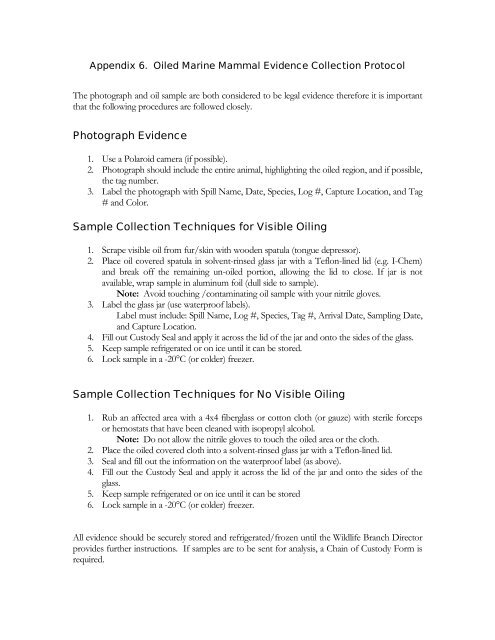Volume III, Appendices EM - National Marine Fisheries Service ...
Volume III, Appendices EM - National Marine Fisheries Service ...
Volume III, Appendices EM - National Marine Fisheries Service ...
Create successful ePaper yourself
Turn your PDF publications into a flip-book with our unique Google optimized e-Paper software.
Appendix 6. Oiled <strong>Marine</strong> Mammal Evidence Collection Protocol<br />
The photograph and oil sample are both considered to be legal evidence therefore it is important<br />
that the following procedures are followed closely.<br />
Photograph Evidence<br />
1. Use a Polaroid camera (if possible).<br />
2. Photograph should include the entire animal, highlighting the oiled region, and if possible,<br />
the tag number.<br />
3. Label the photograph with Spill Name, Date, Species, Log #, Capture Location, and Tag<br />
# and Color.<br />
Sample Collection Techniques for Visible Oiling<br />
1. Scrape visible oil from fur/skin with wooden spatula (tongue depressor).<br />
2. Place oil covered spatula in solvent-rinsed glass jar with a Teflon-lined lid (e.g. I-Chem)<br />
and break off the remaining un-oiled portion, allowing the lid to close. If jar is not<br />
available, wrap sample in aluminum foil (dull side to sample).<br />
Note: Avoid touching /contaminating oil sample with your nitrile gloves.<br />
3. Label the glass jar (use waterproof labels).<br />
Label must include: Spill Name, Log #, Species, Tag #, Arrival Date, Sampling Date,<br />
and Capture Location.<br />
4. Fill out Custody Seal and apply it across the lid of the jar and onto the sides of the glass.<br />
5. Keep sample refrigerated or on ice until it can be stored.<br />
6. Lock sample in a -20°C (or colder) freezer.<br />
Sample Collection Techniques for No Visible Oiling<br />
1. Rub an affected area with a 4x4 fiberglass or cotton cloth (or gauze) with sterile forceps<br />
or hemostats that have been cleaned with isopropyl alcohol.<br />
Note: Do not allow the nitrile gloves to touch the oiled area or the cloth.<br />
2. Place the oiled covered cloth into a solvent-rinsed glass jar with a Teflon-lined lid.<br />
3. Seal and fill out the information on the waterproof label (as above).<br />
4. Fill out the Custody Seal and apply it across the lid of the jar and onto the sides of the<br />
glass.<br />
5. Keep sample refrigerated or on ice until it can be stored<br />
6. Lock sample in a -20°C (or colder) freezer.<br />
All evidence should be securely stored and refrigerated/frozen until the Wildlife Branch Director<br />
provides further instructions. If samples are to be sent for analysis, a Chain of Custody Form is<br />
required.
















